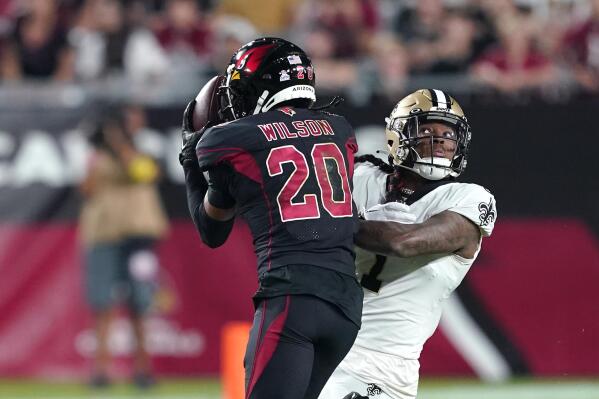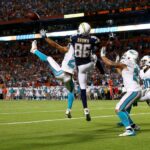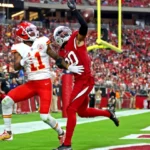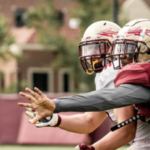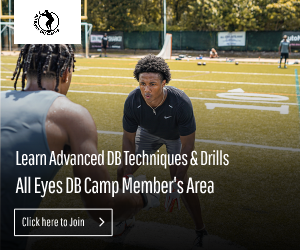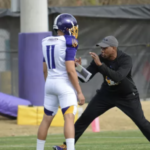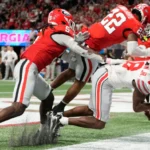As a defensive back, excelling in man coverage requires a combination of athleticism, technique, and football IQ. In this guide, I will break down the essential elements of playing man coverage effectively. Some of these things are very basic but they bear repeating and you may find some of the elements I point out interesting. They may even be thought provoking.
I entered college football playing in a 90% man system. Our defensive coaches believed in man coverage. Not only did they believe in man coverage, they believed in “bump and run” man coverage. It didn’t matter if it was 3rd and 3 or 3rd and 15, we were pressing. My defensive back coaches my first two seasons of college football were former Oakland Raiders, so there’s that.
As a coach, I ran systems in some years that were predominantly zone based and other years, I was heavy on man. Over the course of all of this playing and coaching, I have found the following elements to be true in excelling at man to man coverage.
Stance and Alignment
Begin with a solid stance that allows for quick reactions. Feet should be shoulder-width apart, knees slightly bent, and weight on the balls of the feet. Align yourself based on the receiver’s tendencies, taking into account their strengths and weaknesses. It starts with your stance as many good DB coaches would say. The stance should be comfortable but should also put you in position to react efficiently and effectively to the receiver’s movement. When in press, the receiver’s first move can be sudden. Be in a stance that can match that suddenness with a level of balance. Equally as important is the alignment. Where is your help? Knowing that can allow you to align with proper leverage. Is your help inside? Align with proper outside leverage. Is the help outside or over the top? Align with the proper inside leverage. Finally, the most overlooked part of alignment is depth. In press, find the proper amount of depth that does not make you panic on the first move but also does not allow the receiver too much space to outmaneuver you before you can affect his route. More on the proper press stance here. If you are playing off, stay out of no man’s land. That is where you can’t be aggressive nor are you able to stay in good position over the top. Typically seven yards off is best but can be adjusted according to hash, formations and situations.
Mirror and Match
The cornerstone of effective man coverage is mirroring the receiver’s movements. Keep your eyes on the receiver’s hips, as they provide subtle cues for route direction. Maintain a proper distance, allowing you to react to changes in speed and direction. Whether you are aggressive in press or passive, the ability to mirror and match is key in winning your reps. Being able to move with lateral movements as well as stay on the hip in and out of breaks will determine your man to man worthiness. This also holds true in off man. Being able to weave with a stem and turn effectively to match deep routes will give you the ability to be there when the ball arrives. An emphasis on having quick feet and efficient movements in your kick, pedal and turns is very important.
Hand Placement
Use your hands correctly to disrupt the receiver’s route without drawing penalties. Press coverage at the line of scrimmage can be a valuable tool to throw off the timing between the quarterback and receiver. Focus on redirecting the receiver while maintaining balance. Often times, young and inexperienced defensive backs over rely on their hands in press coverage. This leads to being in poor position and penalties. Other times, defensive backs don’t use their hands at all or choose to strike in the wrong places. Don’t take your hands for granted. When and where you place them on a receiver can make the difference between winning and losing a rep. Practice striking receivers in the right spots. More on hand placement in press here.
Hip-Turn Technique
When the receiver makes their move, smoothly transition into a hip-turn technique. Open your hips toward the sideline while keeping your eyes on the receiver. This allows you to maintain coverage while turning and running with the receiver. I have been surprised how little defensive backs train this aspect of their game. Many just take their turn both out of a back pedal and out of press for granted. You can lose 2-3 steps on a wide receiver by in-effectively turning. Playing man coverage has a lot to do with taking proper angles and that starts with making proper turns. Don’t learn this the hard way. Instead, learn the proper way to turn your hips and watch how you find yourself in proper position more often. More on turning out of your backpedal here.
Maintaining Positioning
Stay in the receiver’s hip pocket throughout the route. This positioning minimizes the quarterback’s window for a successful throw, making it challenging for the receiver to make a play. Anticipate the receiver’s breaks and cuts, adjusting your positioning accordingly. Doing this requires having a football IQ as well as proper agility, balance and training. It is very possible to do well at the line of scrimmage versus a receiver and get blown away down the field by not being able to maintain proper position. Your ability to match vertical routes as well as routes that break off must be trained. It’s not just about the line of scrimmage. You have to lock on down the field too.
Eye Discipline
Disciplined eyes are crucial. Avoid peeking into the backfield too early, as this can lead to losing track of the receiver. Keep your eyes on the receiver until the last possible moment, maintaining awareness of both the receiver and the quarterback’s intentions. Knowing when to look for the football is a superpower. Eye discipline is the most crucial element of a DB’s success especially when in man coverage. This is the reason that I named my company All Eyes DB Camp. You must train your eyes to be disciplined. Lock in on that receiver’s waist when in press and off man. Try to remain focused and not have your eyes wander into the backfield or on surrounding receivers that are not your responsibility. Like all other aspects of man coverage, eye discipline is a skill and must be trained.
Reacting to the Football
When the ball is in the air, it’s time to become a playmaker. Turn your head towards the football, locate it in the air, and go for the interception or make a deflection. Timing and ball skills are essential for successful outcomes in man coverage. This element right here is the one that separates the contenders from the pretenders. Guys that are too scared to look for the football don’t last long as cornerbacks. They are prone to getting beat and getting penalties. However, a defensive back that has a knack for knowing when the ball is coming and is not afraid to see the prize is the one you see piling up the INTs. Make it a habit of looking for the football when you are in good position. This starts in practice and will eventually come out during games. Being a ballhawk means actually looking for the ball when it’s in flight.
Fitness and Conditioning
Man coverage demands peak physical conditioning. A well-conditioned defensive back can maintain coverage throughout the game, staying step-for-step with receivers even in late-game situations. This is perhaps the most underrated one of the elements. As someone who has played over 50 snaps of man coverage in a game before, I am here to tell you that if you are not in shape you are going to get got. If you like coming to the line of scrimmage lining up in front of dangerous wide receiver feeling like a fat man who just climbed 20 flights of stairs then don’t take your conditioning seriously. I am here to tell you that it’s a horrible feeling. It’s also when you commit penalties or flat out let the team down by getting handled by the receiver. Don’t let it be you. You should always be in shape as a defensive back but even more so if your team runs a lot of man coverage.
Confidence
The biggest part of all of this is mental. It takes a tremendous amount of confidence to line up in front of a skilled wide receiver with a bunch of people watching. Doing your work to acquire all of the elements discussed in this article will do wonders for your confidence. Training and studying give you super human powers mentally. When you know you have outworked the next man, you tend to worry a lot less. As a defensive back that plays man coverage, you will get beat. You can’t let it affect you and you can’t run around caring what people think. It’s common for fans with very little knowledge of your position to make derogatory comments when a receiver catches a ball on you. Realize they are speaking from ignorance and move on to the next rep or game. As long as you keep playing, you’ll get your victories.
Excelling at man coverage requires a lot of key ingredients. Some of these ingredients are aided by having some good genes. However, a majority of them can be trained and developed through steady work. That work involves acquiring the knowledge, being dedicated to the training and executing when you are out on the field. Having confidence is a big key to pulling it all together. If you put in the time and effort in you will see the results. Soon you will be considered one of the toughest man to man coverage guys on your team, area and region.
Chad Wilson is the owner of All Eyes DB Camp and author of "101 DB Tips". He played college football at the University of Miami and briefly in the NFL for the Seattle Seahawks. Over his 15 year high school football coaching career, he tutored over a dozen Division I defensive backs and as a trainer has worked with NFL All Pros, first round draft picks, college football All Americans and Top 10 ranked high school football prospects.

